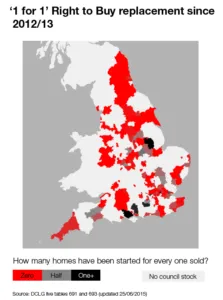Right to Buy replacements: When nine become one.
Published: by Rachael Emmett
In the Queen’s speech, the Government reiterated its intention to extend Right to Buy to people renting from housing associations. Properties owned by housing associations to rent to people at less than the market rate will now be offered to those tenants to buy, allowing more people to become homeowners.
In principle, this sounds like a great idea and when it was first introduced in the 1980s to council tenants I can certainly see why it was popular with the electorate, when almost a third were social renters.
The real problem is that this stock – that had given generations of low-income households a decent home at a low rent – was lost to the social sector and never replaced. In response to this criticism, the previous coalition Government promised that “every additional home that is sold will be replaced by a new affordable home on a one-for-one basis”.
Unfortunately though, in the three years since this promise was made, figures released today show that only one home has been replaced for every nine that have been sold. This is a pretty poor record so far. Whilst 29,505 homes have been sold over that time, only 3,422* homes have been started in replacement.
It’s no wonder that promises this time around of replacing homes sold are met with derisive snorts from those in the sector.
There’s also the problem that there will always be a lag between sales and building more, and so a downward pressure on social rented housing stock is inevitable at any point with sales ongoing. Therefore, replacing homes only after they are sold is never going to be an effective way of ensuring there are always enough homes.
Across England, there are also large disparities in where stock is being replaced. The North West is looking particularly dry with only two homes started in replacement compared with the 1,264 that have been sold through Right to Buy in the same time.
The most striking thing in the map above is the number of local authorities that have no council stock because they’ve already transferred them to housing associations. The extension of Right to Buy to these tenants could dry up homes available for low-income households in more areas than it already does now.
At a time when 1.4 million children are pushed below the poverty line solely due to high housing costs, it’s time that the Government realised that selling off some of our last affordable homes isn’t going to help the lives of families up and down the country.
*This excludes the 2014/15 Q4 Hounslow start figures which are subject to confirmation, as per DCLG’s figures in Table 693

